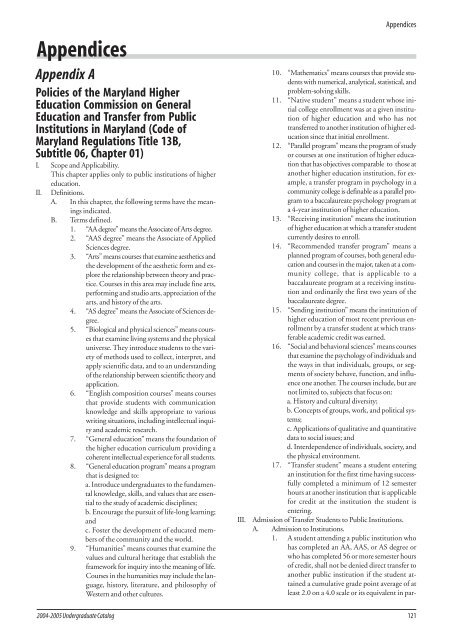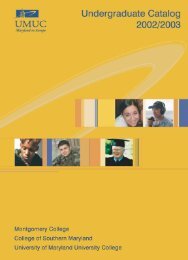Statements of Policy - UMUC Europe
Statements of Policy - UMUC Europe
Statements of Policy - UMUC Europe
Create successful ePaper yourself
Turn your PDF publications into a flip-book with our unique Google optimized e-Paper software.
Appendices<br />
Appendix A<br />
Policies <strong>of</strong> the Maryland Higher<br />
Education Commission on General<br />
Education and Transfer from Public<br />
Institutions in Maryland (Code <strong>of</strong><br />
Maryland Regulations Title 13B,<br />
Subtitle 06, Chapter 01)<br />
I. Scope and Applicability.<br />
This chapter applies only to public institutions <strong>of</strong> higher<br />
education.<br />
II. Definitions.<br />
A. In this chapter, the following terms have the meanings<br />
indicated.<br />
B. Terms defined.<br />
1. “AA degree” means the Associate <strong>of</strong> Arts degree.<br />
2. “AAS degree” means the Associate <strong>of</strong> Applied<br />
Sciences degree.<br />
3. “Arts” means courses that examine aesthetics and<br />
the development <strong>of</strong> the aesthetic form and explore<br />
the relationship between theory and practice.<br />
Courses in this area may include fine arts,<br />
performing and studio arts, appreciation <strong>of</strong> the<br />
arts, and history <strong>of</strong> the arts.<br />
4. “AS degree” means the Associate <strong>of</strong> Sciences degree.<br />
5. “Biological and physical sciences” means courses<br />
that examine living systems and the physical<br />
universe. They introduce students to the variety<br />
<strong>of</strong> methods used to collect, interpret, and<br />
apply scientific data, and to an understanding<br />
<strong>of</strong> the relationship between scientific theory and<br />
application.<br />
6. “English composition courses” means courses<br />
that provide students with communication<br />
knowledge and skills appropriate to various<br />
writing situations, including intellectual inquiry<br />
and academic research.<br />
7. “General education” means the foundation <strong>of</strong><br />
the higher education curriculum providing a<br />
coherent intellectual experience for all students.<br />
8. “General education program” means a program<br />
that is designed to:<br />
a. Introduce undergraduates to the fundamental<br />
knowledge, skills, and values that are essential<br />
to the study <strong>of</strong> academic disciplines;<br />
b. Encourage the pursuit <strong>of</strong> life-long learning;<br />
and<br />
c. Foster the development <strong>of</strong> educated members<br />
<strong>of</strong> the community and the world.<br />
9. “Humanities” means courses that examine the<br />
values and cultural heritage that establish the<br />
framework for inquiry into the meaning <strong>of</strong> life.<br />
Courses in the humanities may include the language,<br />
history, literature, and philosophy <strong>of</strong><br />
Western and other cultures.<br />
Appendices<br />
10. “Mathematics” means courses that provide students<br />
with numerical, analytical, statistical, and<br />
problem-solving skills.<br />
11. “Native student” means a student whose initial<br />
college enrollment was at a given institution<br />
<strong>of</strong> higher education and who has not<br />
transferred to another institution <strong>of</strong> higher education<br />
since that initial enrollment.<br />
12. “Parallel program” means the program <strong>of</strong> study<br />
or courses at one institution <strong>of</strong> higher education<br />
that has objectives comparable to those at<br />
another higher education institution, for example,<br />
a transfer program in psychology in a<br />
community college is definable as a parallel program<br />
to a baccalaureate psychology program at<br />
a 4-year institution <strong>of</strong> higher education.<br />
13. “Receiving institution” means the institution<br />
<strong>of</strong> higher education at which a transfer student<br />
currently desires to enroll.<br />
14. “Recommended transfer program” means a<br />
planned program <strong>of</strong> courses, both general education<br />
and courses in the major, taken at a community<br />
college, that is applicable to a<br />
baccalaureate program at a receiving institution<br />
and ordinarily the first two years <strong>of</strong> the<br />
baccalaureate degree.<br />
15. “Sending institution” means the institution <strong>of</strong><br />
higher education <strong>of</strong> most recent previous enrollment<br />
by a transfer student at which transferable<br />
academic credit was earned.<br />
16. “Social and behavioral sciences” means courses<br />
that examine the psychology <strong>of</strong> individuals and<br />
the ways in that individuals, groups, or segments<br />
<strong>of</strong> society behave, function, and influence<br />
one another. The courses include, but are<br />
not limited to, subjects that focus on:<br />
a. History and cultural diversity;<br />
b. Concepts <strong>of</strong> groups, work, and political systems;<br />
c. Applications <strong>of</strong> qualitative and quantitative<br />
data to social issues; and<br />
d. Interdependence <strong>of</strong> individuals, society, and<br />
the physical environment.<br />
17. “Transfer student” means a student entering<br />
an institution for the first time having successfully<br />
completed a minimum <strong>of</strong> 12 semester<br />
hours at another institution that is applicable<br />
for credit at the institution the student is<br />
entering.<br />
III. Admission <strong>of</strong> Transfer Students to Public Institutions.<br />
A. Admission to Institutions.<br />
1. A student attending a public institution who<br />
has completed an AA, AAS, or AS degree or<br />
who has completed 56 or more semester hours<br />
<strong>of</strong> credit, shall not be denied direct transfer to<br />
another public institution if the student attained<br />
a cumulative grade point average <strong>of</strong> at<br />
least 2.0 on a 4.0 scale or its equivalent in par-<br />
2004-2005 Undergraduate Catalog 121






